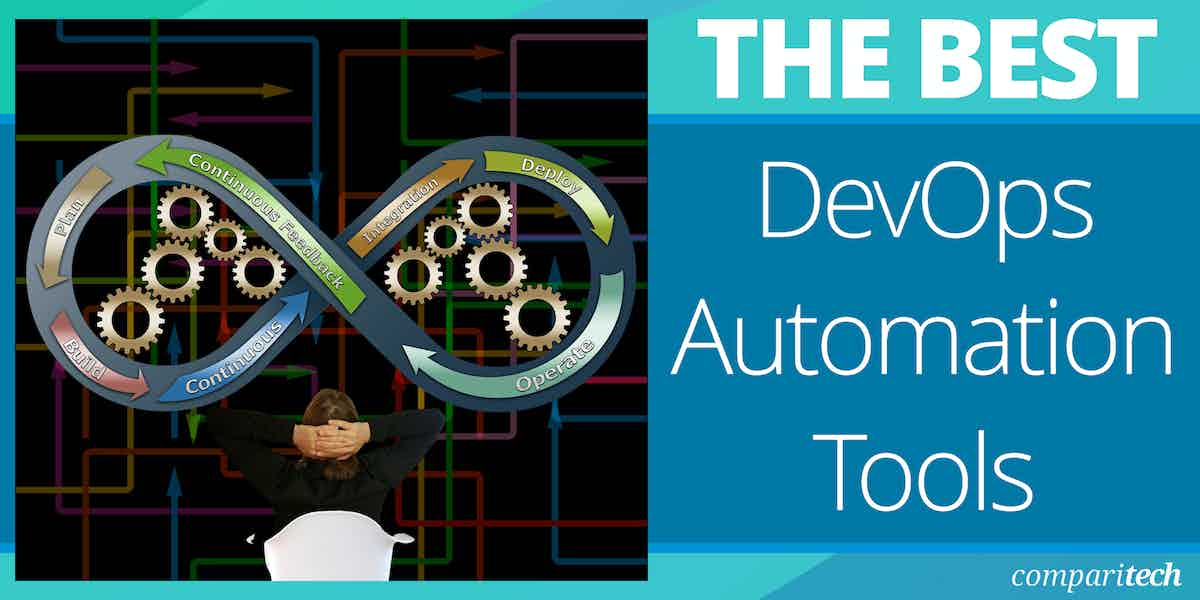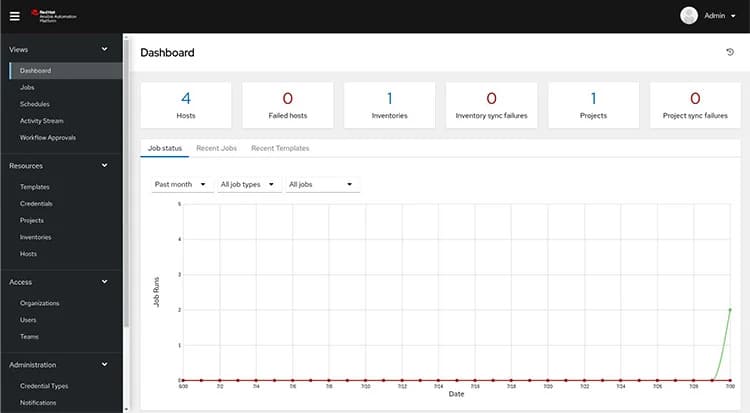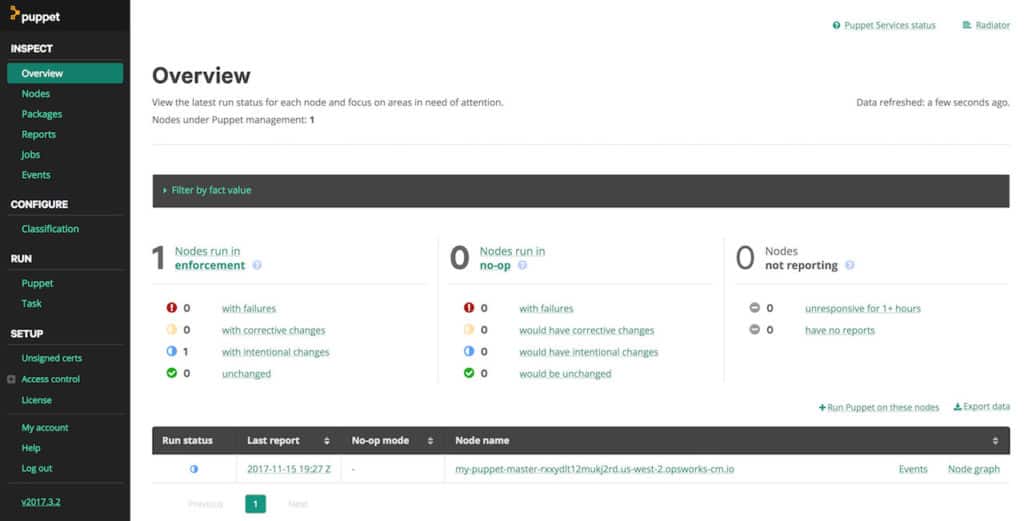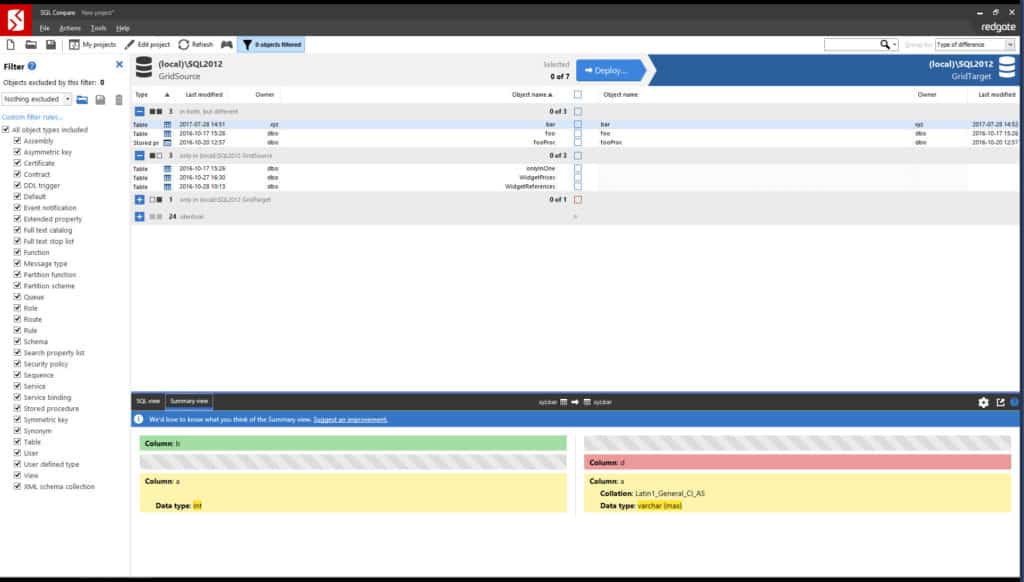DevOps is a term used to describe combining software development teams (comprised of software developers, and quality assurance engineers) with IT operations teams (made up of system engineers, and network administrators).
The entire DevOps philosophy is about encouraging collaboration between development staff and IT operations to speed up the product delivery pipeline.
Closer collaboration between software development and IT operations teams allows companies to create and refine software products much faster than in a silo environment. DevOps has become popular because it enables these teams to communicate on project changes and reduces the cost of development.
Here is our list of the Best DevOps Automation Tools:
- Tricentis Testim EDITOR’S CHOICE This AI-driven test automation platform simplifies test creation, maintenance, and execution for web applications. It features smart locators, self-healing tests, and CI/CD integration. This is a cloud-based system with on-device agents for iOS and Android. Get a 14-day free trial.
- Tricentis Testim Mobile (FREE TRIAL) Opt for this Tricentis product if you want to test mobile apps rather than Web applications. Get a 14-day free trial.
- Red Hat Ansible Automation Platform A work scheduling application with live performance graphs and goal notifications.
- Chef Infra An automated configuration manager and patch installer.
- Terraform This platform enables you to plan and manage infrastructure through codable workflow screens.
- SonarQube A program code verifier that spots bugs and schedules revisions and releases. Available in free and paid versions.
- Puppet An infrastructure management platform with coded workflow automation.
- New Relic A centralized performance monitor for devices, applications, and services.
- Datadog Metrics, Traces, & Logs Monitoring This is a cloud-based subscription service that includes modules for network, server, and application monitoring plus traffic and code analysis tools.
- RedGate SQL Toolbelt A database creation, development, management, and monitoring tool for SQL Server.
Once DevOps merged the disparate worlds of development and operations, automation became a top priority for many organizations. But first, let’s take a closer look at what DevOps is and why automation is important.
Why is Automation Important?
For companies using DevOps, automation is essential because it eliminates manual tasks that slow down application delivery. An automated solution can automatically complete manual tasks that would usually be done by a human user. Automation thus enables technical staff to focus on other more important work in the DevOps workflow.
However, automation isn’t a one-size-fits-all solution. After all, you can’t automate everything! To use automation effectively, companies have to run an audit first. The audit identifies which processes can be automated. Identifying potential use cases for automation ahead of time helps to onboard new solutions smoothly.
The Best DevOps Automation Tools
DevOps raises many challenges, none more significant than trying to deliver software efficiently with minimal bugs. Automated solutions like the tools listed below are critical for enabling enterprises to deploy and test software.
Our methodology for selecting a DevOps automation tool
We reviewed the market for DevOps automation solutions and analyzed tools based on the following criteria:
- Orchestration to allow software produced by different vendors to exchange data
- Support systems that cater to both development and the management of live systems
- Security testing considerations
- Bug tracking
- Workflow integration
- A free trial or a demo system for a no-cost assessment opportunity
- Good value for money delivered by a tool that works well as part of a suite and is marketed at a fair price
With these selection criteria in mind, we derived a list of efficient DevOps automation systems that increase productivity in both development and system management.
1. Tricentis Testim (FREE TRIAL)
Tricentis Testim is an AI-powered test automation platform designed to streamline the process of creating, maintaining, and executing automated tests for web applications. Testim stands out for its use of artificial intelligence to simplify test creation and enhance the stability and reliability of automated tests, especially in dynamic and rapidly evolving environments.
Key Features
- AI-powered test creation
- Smart locators for Web page features
- Self-healing tests
- Record and replay option
- Version control
Why do we recommend it?
Tricentis Testim provides automated methods to generate test scripts for Web applications, such as websites. Testing all the pages can involve following many different paths, activating interactive elements, such as buttons or drop-down lists. This is a great time saver for testing applications that have many possible variations.
Testim uses AI to automatically identify and maintain element locators (such as buttons, fields, etc.) in your web application. This is a self-healing capability that adapts tests to changes in the Web application interface when retesting or checking through adaptations.
The platform can execute tests across different browsers and platforms to ensure consistent performance. Tests can be run in parallel, speeding up the testing process – a valuable feature for continuous integration and continuous delivery (CI/CD) pipelines.
Set up walk-through tests with a recorder feature that generates test scripts without the need for coding skills. Testim integrates with version control systems, such as Git, enabling users to manage test cases alongside their application code.
Who is it recommended for?
Testim facilitates collaboration among team members by allowing them to share and review test cases, comments, and results in a centralized platform. In Agile and DevOps settings, where rapid iterations and continuous delivery are critical. The platform is ideal for teams that include both technical and non-technical members, as its codeless features allow everyone to contribute to test automation.
Pros:
- Detailed test execution reports, including screenshots, logs, and step-by-step breakdowns of what happened during a test
- The platform can detect flaky tests supporting the improvement of the test suite
- The system integrates seamlessly with CI/CD tools like Jenkins, CircleCI, and GitLab, allowing for continuous testing as part of the software delivery pipeline.
- JavaScript support
- Users can create custom actions or components that can be reused across multiple tests
Cons:
- No price list
Tricentis Testim is a powerful and innovative tool that leverages AI to simplify and enhance test automation for web applications. However, the company doesn’t publish its price list. You can assess the Trestim system by accessing a 14-day free trial.
EDITOR'S CHOICE
Tricentis Testim is our top pick for a DevOps automation tool because this platform enables you to formulate a template for a Web application so even if your developers change the labels of buttons or redesign fields, you don’t have to rewrite the test script. The package recognizes each element as a locator – a placeholder – so it can continue to operate even when comparing two different versions of the same screen. The tool uses AI to manage all of these variables. The test creation process is eased with a recording service, so run through your test and store those actions to rerun them on a site over and over again, trying different browsers and looking for errors. The service produces detailed bug reports that make fixes easier to implement. The package will integrate into CI/CD pipelines for DevOps processes and it is also suitable for Agile development projects.
Download: Get a 14-day FREE Trial
Official Site: https://app.testim.io/#/signup
OS: Cloud-based
2. Tricentis Testim Mobile (FREE TRIAL)
Tricentis Testim Mobile adds a menu of virtual mobile devices to the Testim package. This is the Tricentis Testim system, but for testing mobile apps. The service includes a long list of specific makes and models of mobile devices, so you can test the quirks of different smart products and make sure that your mobile app doesn’t hit an anomaly in the architecture of those popular devices.
Key Features
- Virtual devices for testing
- A cloud-based platform
- AI-based testing system
- Record and replay walk throughs
Why do we recommend it?
Tricentis Testim Mobile provides all of the AI-driven features of Tricentis Testim but runs tests on mobile devices rather than through Web browsers. This is a test platform for mobile apps rather than for Web applications or websites. The main difference between the two Testim systems is the menu of virtual devices that are available on the Testim Mobile system.
Similar to Testim for Web applications, Testim Mobile uses AI to manage and maintain element locators, ensuring tests remain stable even when the mobile app’s UI changes. Users can create automated tests for mobile apps through a visual interface without needing to write code, making test automation accessible to a broader range of team members. The platform automatically updates tests in response to changes in the app’s UI, reducing the need for manual intervention and minimizing test maintenance efforts.
Testim Mobile supports automated testing for both Android and iOS applications, allowing teams to test across multiple devices and operating systems. Tests can be executed on real devices to ensure accuracy and reliability, providing insights into how the app performs in real-world conditions.
Who is it recommended for?
Testim Mobile integrates with popular CI/CD tools, allowing mobile tests to be included in the continuous integration and continuous delivery pipelines, supporting automated testing throughout the development lifecycle. With codeless test creation, Testim Mobile enables both technical and non-technical team members to contribute to test automation.
Pros:
- CI/CD integration
- Self-healing tests spot cosmetic changes to app features
- Alerts to inconsistent results
- Provides diagnostics for discovered bugs
Cons:
- Easier to use virtual devices off the menu than an actual physical device in your office
You can get the Testim Mobile service as an addition to the Testim package, enabling you to test both Web applications and mobile apps. Try out this package with a 14-day free trial.
3. Red Hat Ansible Automation Platform
Red Hat Ansible Automation Platform is an automation platform that is designed to help teams communicate. When using Red Hat Ansible you can view real-time job output version through a dashboard. Jobs can be scheduled to manage future projects.
Key Features
- Project task scheduler
- Coordinates workflows
- Manages data exchanges
- Completion notification by email or messaging app
- Conditional workflow progress
Why do we recommend it?
Red Hat Ansible Automation Platform provides a control plane to integrate workload automation into a DevOps environment. The administrator sets up links to development project management tools, such as GitHub, GitLab, JIRA, Selenium, Jenkins, and Bamboo, and the Ansible system acts as a hub for alert management and feedback.
To monitor jobs the user has a Job Status graph to monitor alongside supporting metrics such as Hosts, Failed Hosts, Inventories, Inventory Sync Failures, Projects, and Project Sync Failures. Having all of this information on hand makes it easy for multiple teams to monitor the progress of the DevOps pipeline.
With Ansible Tower Workflows you can create representations of complex processes. These workflows can chain together multiple playbooks and workflows depending on your requirements. For example, you can create a workflow that creates an application, deploys it, runs tests, and then automatically promotes those with successful results.
To ensure integration with your team Red Hat Ansible Automation Platform has notifications. Notifications let you know when a job has been completed. Notifications can be sent through email, SMS, Slack, Hipchat, PagerDuty, and more. These notifications make sure that your team is always updated on workflow progress.
Who is it recommended for?
This is a good tool for DevOps teams because it can be integrated into the whole process from project inception through to day-to-day operations management. The tool can coordinate the release of code and its performance monitoring. It can be hosted on any of the major cloud platforms, including AWS, Azure, and Google Cloud Platform.
Pros:
- Excellent interface – provides high-level insights and easy-to-access details
- Displays and tracks workflows and offers intuitive task scheduling
- Great for collaboration, supports notifications as well as integrations into messaging platforms
- Great options for both small and large dev teams
Cons:
- Offers many different options which can take some time to fully explore
There are two versions of Red Hat Ansible Automation Platform available to purchase: Standard and Premium. The Standard version comes with 8-to-5 support. The Premium Version has 24/7 support. To view the price for either version you will have to contact the company directly for a quote. You can download the free trial.
4. Chef Infra

Chef Infra is an infrastructure automation tool that automates configuration management and deployment. Configurations can be updated automatically based on the environment or hardware. There is also a patch management capability so that teams can patch infrastructure remotely.
Key Features
- Automation for configuration management
- Onboarding workflows
- Patch management
- Activity logging
Why do we recommend it?
Progress Chef Infra is a configuration management system for applications, which include cloud systems and Web applications. DevOps teams need a system like Chef Infra to set up deployment installation packages. The tool sets the environment for software and alters the host system to conform to these requirements during the installation process.
Interaction with Chef Infra takes place through the Chef automation language, which is easy to write so even inexperienced users can start creating their own commands and automating manual tasks.
There are two main Chef Infra packages available: Effortless Infrastructure and Enterprise Automation Stack. The Effortless Infrastructure version comes in two versions: Essentials, and Enterprise. The Essentials version supports 100 nodes and 100 targets for $16,500 (£12,706) per year. The Enterprise version supports 500 nodes and 500 targets for $75,000 (£57,758) per year.
Who is it recommended for?
Sometimes, operating environments can disable the functionality of a software system if they are not configured correctly. Leaving these issues to the user can result in steps being missed out, leading to a lot of support calls and complaints. This package makes sure that the operating environment of a software package conforms to requirements.
Pros:
- Works to automate workflows, configurations, and patching
- Uses a simplified automation language called Chef
- Users can draft on-boarding workflows or use templates
Cons:
- Features and pricing is suited for larger dev teams and environments
The Enterprise Automation Stack also comes in two versions: Essentials and Enterprise. The Essentials version starts at 100 nodes with 100 targets and 100 service instances for $35,000 (£26,954) per year. The Enterprise version includes 500 nodes, 500 targets, and 500 service instances for $150,000 (£115,517) per year. You can try Chef Infra for free.
5. Terraform
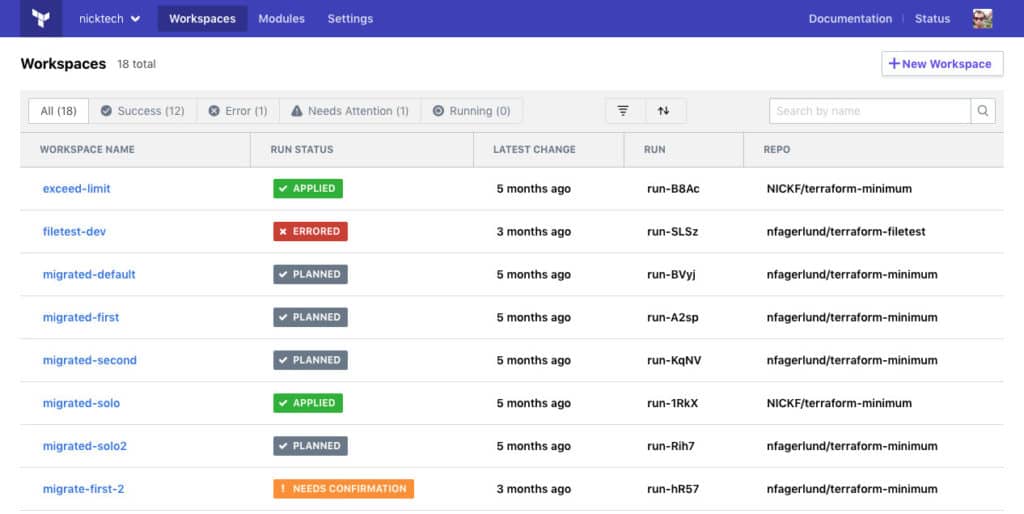
Terraform is a solution that allows you to write infrastructure as code and manage your infrastructure and IT services. You can write configuration files and share them with others to collaborate. There is also the ability to automate provisioning and create new resources for your team. Resource dependencies are mapped so the user can identify exactly how infrastructure changes protect normal processes.
Key Features
- Configuration automation
- Onboarding workflows
- Code development controls
Why do we recommend it?
Terraform is similar to Chef Infra except that it focuses on installation settings for cloud-based systems. This tool will set up the environment requirements for a package at the point that it is installed. The service can be used for entire platforms, such as SaaS systems
There are many features that support the automation of workflows with Terraform. For example, there is VCS integration with GitHub, BitBucket, and GitLab to help manage source code changes more efficiently. There are also notifications to notify the user about run events. Notifications can be sent through Slack or webhooks, which is ideal for remote teams.
There are three versions of Terraform available to purchase: Free, Team, and Governance. The Free version supports up to five users and offers features like VCS integration and remote operations.
Who is it recommended for?
This service is useful for logging environment requirements during development and ensuring that test systems are set up correctly. Moving through to release, the tool provides a package to ensure that configurations and infrastructure are all correct so that the new system can run properly. The tool doesn’t include ongoing performance or security monitoring.
Pros:
- Simplifies writing infrastructure as code
- Offers provisioning automation
- Uses integrations with multiple repositories to help manage and secure source code more effectively
Cons:
- Would like to see an in-depth trial version
The Team version costs $20 (£15.40) per user per month with team management and role-based access control. The Governance version costs $70 (£53.91) per user per month with the Sentinel Policy as Code framework and cost estimation features. You can sign up here.
6. SonarQube
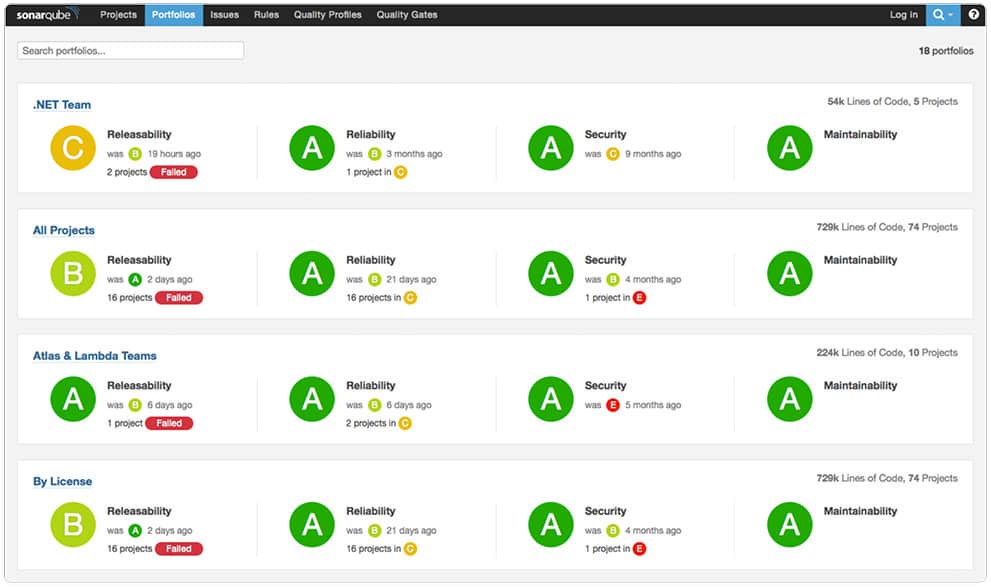
SonarQube is a continuous inspection tool that scans code. To monitor the code, the software uses thousands of unique Static Code Analysis rules to get your code ready for release. The software can detect bugs and vulnerabilities so the user can find a solution. One of the main features is The Quality Gate, which tells the user whether an application passes the criteria for release (which supports the larger QA process).
Key Features
- Code analysis
- Continuous testing
- Integrates with CI/CD pipeline management
Why do we recommend it?
SonarQube is a code quality assurance system. You can run it to work through all of the files in your repository to scan scripts, looking for coding errors and formatting issues. It will highlight where changes should be made. Once all of the backlog has been dealt with, the service will scan each new script as it is logged into the repository.
The product supports over 25 programming languages including Java, JavaScript, C#, C/C++, PHP, Python, and more. The diverse range of programming languages means it is compatible with many types of applications. However, if you require more then you can use plugins to add more languages to the mix (there are over 60 plugins available to use).
There are four versions of SonarQube available: Community, Developer, Enterprise, and Data Center. The Community version is free and open-sourced with code analysis for 15 languages and bug detection. The Developer edition starts at $150 (£115) and includes everything in the community edition plus support for C, C++, Swift, PL/SQL support and more.
Who is it recommended for?
This is a good choice for development teams that need to impose a common coding standard. As the tool imposes coding rules, such as layout formats, it can be a good educational service. This makes it a good choice for businesses that have hired cheaper developers with little experience.
Pros:
- Continuously monitors code for vulnerabilities, errors, and inefficiencies
- Offers numerous QA tools and testing options
- Supports multiple languages and applications through simple plugins
Cons:
- Would like to see more variety in data visualization options
The Enterprise edition starts at $20,000 (£15,402) and includes security reports and portfolio management. The Data Center Edition starts at $130,000 (£100,115) and has extra features like component redundancy and horizontal scalability. You can download SonarQube for free.
7. Puppet
Puppet is a solution designed to automate the delivery of infrastructure and applications. The software enables you to manage infrastructure as code so your team can configure and deploy services more efficiently. There is an automated configuration so you can keep your environment updated constantly.
Key Features
- Focused on development
- Formalizes application environment setup
- Creates delivery and installation packages
Why do we recommend it?
Puppet is an infrastructure deployment and automation platform. It supports structures that are known as “infrastructure as code.” Development teams use this platform to create an environment, using systems such as containers, and then generate creation scripts for those services so that they can be set up in tandem with the software packages that they support.
The product also offers automatic provisioning, which you can configure to automatically provision machines based on the policies you define and deploys the necessary OS or hypervisor. Provisioning in this way speeds up deployment so you can deploy services faster with less manual legwork.
To help speed up your operations there are Puppet Forge modules. These modules are designed to automate everything from Apache Web servers to docker containers and DNS. There are over 5,000 Puppet Forge modules so you have plenty of options you can use to control your infrastructure.
Who is it recommended for?
Puppet users can access a library of connectors to platform and service providers that can easily be plugged into an installation script to set up an IaC framework. This platform is called Puppet Forge and it makes the Puppet service much more accessible to a wider range of cloud system providers.
Pros:
- Sleek dashboard and interface (works well even at scale)
- Designed to deploy infrastructure as code and services through automation
- Users can design and build installation packages
Cons:
- Must contact sales for a quote, but supports a free version
If you’re looking for a tool that simplifies infrastructure management then Puppet is an excellent choice. Puppet is free for up to 10 nodes. If you require more than 10 nodes then you will need to contact the company directly for a quote. You can get the free version here.
8. New Relic
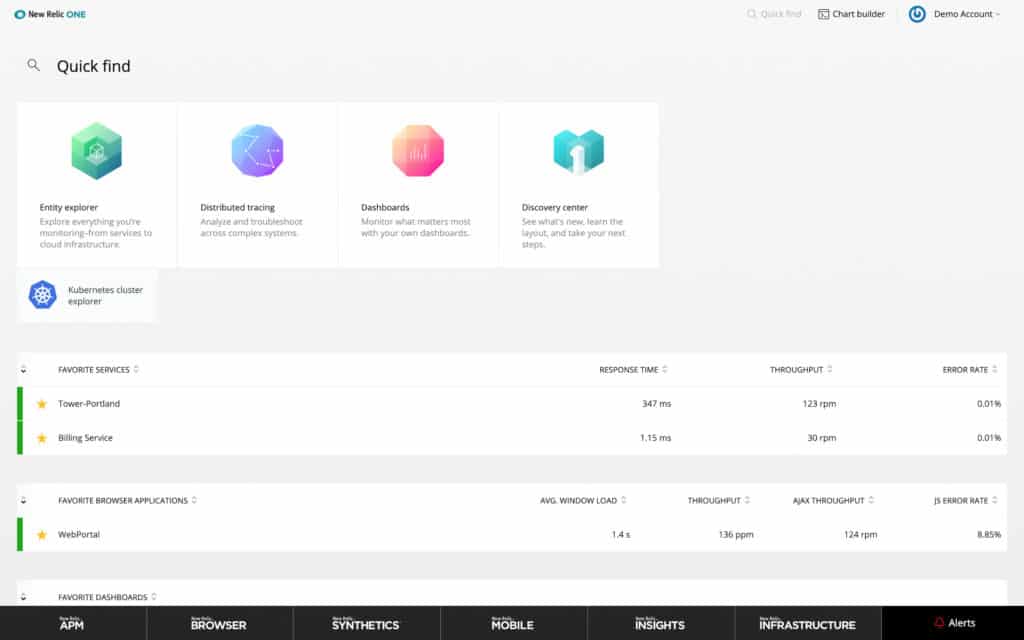
New Relic is a performance monitoring solution that provides top-down visibility over services like devices, applications, and microservices. The tool collects data from entities and displays them with visualization. For example, you can view graphs of Error Rate by App and Total Requests by App to measure application performance.
Key Features
- Application performance monitor
- Bug testing
- Integration with DevOps management tools
Why do we recommend it?
New Relic is a cloud platform of system monitoring and management tools. This system is designed more for operations than for development. However, its error detection system sets up a list of rework requirements that can be fed directly back to the development management service. The service includes a change tracker, which is useful for staged releases.
With over 220 integrations available for New Relic, the software can fit in almost any environment. There is integration available for Elasticsearch, AWS, Google Cloud, Amazon SQS, MongoDB, Oracle, Postgres, RedHat OpenShift, MSSQL, Apache, NGINX, MySQL, and more.
When it comes to resolving incidents, the New Relic AI helps to find the root cause by collecting and prioritizing event data in one pane of glass. The tool will also issue alerts when a human user needs to interact.
You can even respond from inside an external incident management tool like PagerDuty, making it easy to resolve issues quickly. Notifications can be viewed on Slack, Campfire, HipChat, OpsGenie, VictorOps, and more.
Who is it recommended for?
Agile development services would benefit from this package because it enables options such as parallel testing and staged releases. The Change Tracker and Error Inbox are the two part of this system that relate directly to DevOps strategies. Apart from those two units, the platform is almost entirely, an operations management service.
Pros:
- Features a wide range of integrations (great for diverse DevOps environments)
- Provides AI-powered root cause analysis
- Works well with existing incident management tools
Cons:
- Would like to see a trial version for testing verse a demo
There are two versions of New Relic available to purchase: Essentials and Pro. The Pro version starts at $1.20 (£0.92) per month, per instance with additional integrations. The Essentials version starts at $0.60 (£0.46) per month per instance and doesn’t support integrations. You can request a demo.
9. Datadog Metrics, Traces, & Logs Monitoring
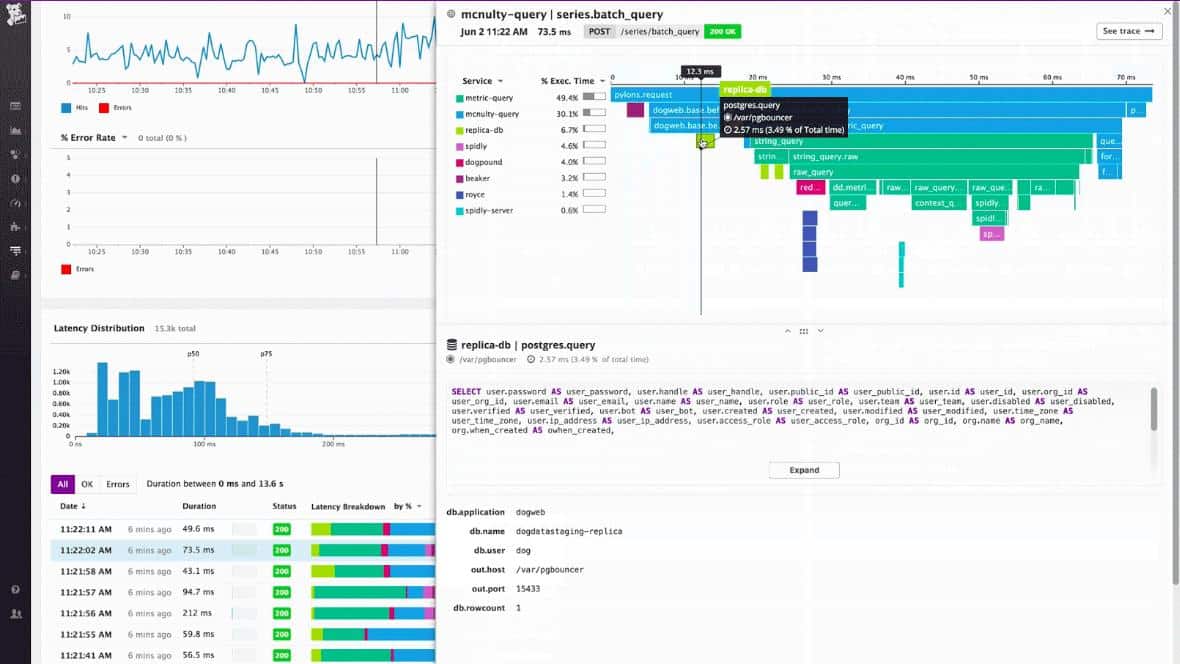
Datadog is a SaaS provider that offers performance tracking, code analysis, log management and system tuning support. The service is available in modules, which include Infrastructure for monitoring hardware performance, Network Performance for traffic analysis, an APM to monitor software and services, and website performance tracking through Synthetic Modelling.
Key Features
- A suite of system monitors
- Includes observability processes
- Integrates with project management tools
Why do we recommend it?
Datadog Metrics, Traces, & Logs Monitoring is a system-wide service on the Datadog cloud platform that can be implemented through its Log Management unit or through its APM. Any of the monitoring tools, such as Infrastructure Monitoring can be set up to generate or forward log messages as well as perform monitoring.
Each module of Datadog can be used as a standalone service, but combinations of services increase the monitoring and analysis capabilities of the system. When introducing a new service in your system, you need to plan hardware capacity against your existing infrastructure to make sure that the system can cope with the extra demand.
The Infrastructure module of Datadog enables you to see day-to-day network and server performance and log their capabilities. The Network Performance module lets you see what spare capacity you have for any increased traffic that new services might bring. These two modules also include analytical tools to support your projections of capacity requirements. The Infrastructure module also maps your servers and identify which are running out of space and which have spare capacity.
If you run a website, you need to keep tabs on its performance. The site should be available at all times to all corners of the earth and the Synthetic Monitoring module of Datadog provides that through uptime monitoring. The Synthetic Modelling service also allows you to create your own walk-through tests to make sure that new features in a site won’t slow down the delivery of web pages.
Who is it recommended for?
The Datadog platform is extensive and it keeps growing. Lately, the company has added on security monitoring services, which exploit the traces and log management features of the other modules. New modules also include a continuous testing service for DevOps teams that is available in API, Web applications, and mobile app formats.
Pros:
- Excellent data visualizations and interface options
- Can help teams track performance, automate tasks, and estimate future infrastructure needs
- Is available as a flexible subscription model, making is accessible to nearly all teams
- Offers highly accurate synthetic testing
Cons:
- Would like to see a longer 30-day trial
Datadog is a subscription service and each module has different plan levels. Datadog Infrastructure even has a Free version and many of the services are charged by volume, which makes this monitoring system appropriate for all sizes of enterprises. All of the Datadog products can be examined on 14-day free trials.
10. Redgate SQL Toolbelt
Redgate SQL Toolbelt is a SQL server development and deployment management tool that can be used to deploy and monitor SQL servers. SQL Change Automation automates database delivery, building, and testing while providing instant feedback on code changes. You can even write tests for databases. The SQL change automation feature is advantageous because it allows you to check code changes more efficiently. There is also integration with Visual Studio Team Services and Octopus Deploy.
Key Features
- DevOps services for SQL Server
- Testing and deployment features
- Integrates with issue tracking and project management tools
Why do we recommend it?
Redgate SQL Toolbelt Essentials is one of many database development and management systems. This package supports SQL Server, while other systems available from Redgate can also support Oracle, PostgreSQL, MySQL, and other DBMSs. This system includes database design and extension services for development projects. The system also includes a developer view of a database.
SQL Compare Pro and SQL Data Compare Pro can also sync different databases together. You can enter the changes you want to deploy and then use a script to deploy your modifications. The comparison feature helps centralize database management.
To help you catch bugs early on, there is a feature called the SQL Data Generator. SQL Data Generator collects data from load testing and integration tests. You can work through the command line in Python to generate additional data. There are over 60 built-in generators available out of the box.
Who is it recommended for?
The package is intended primarily for use by DBAs and database designers. The database can be set up on a development instance and then made available to coders through a viewer that enables tables and columns to be picked for inclusion in SQL and it will link through to indexes to guide developers towards more efficient queries.
Pros:
- Great option for dev teams that rely heavily on SQL environments
- Can automate database testing, management, and configurations
- Offers built-in testing to help verify code before publishing
Cons:
- Would like to see a longer trial
There are two versions of Redgate SQL Toolbelt available to purchase: SQL Toolbelt Essentials, and SQL Toolbelt. SQL Toolbelt Essentials costs $1,985 (£1,528) per license with 11 SQL server tools included. SQL Toolbelt costs $3,495 (£2,691) per license and comes with 14 SQL server tools. You can download the 14-day free trial.
DevOps Automation Makes You More Efficient
Without automation, the workload of engineers and developers becomes unmanageable very quickly. Incorporating automated tools like Datadog, Red Hat Ansible Automation Platform, Chef Infra, and Terraform into your technology stack reduces your team’s workload and makes them more efficient.
DevOps automation FAQs
Is DevOps the same as Automation?
DevOps and automation don’t mean the same thing but automation can be applied to DevOps tools. DevOps is the management strategy of merging the development and operations team in organizations that create new applications. This philosophy gets better value out of skilled technical resources and also improves services to customers because the team supporting an application is the same group that wrote it. Tools that support DevOps are also more efficient because many of the monitoring and management requirements of operations software would also support development teams. Automation removes the need for humans to perform tasks within the workflow of an IT process. This field of services is particularly useful for flowing information from one management tool to another. So, automation helps in the management of a CI/CD pipeline used by DevOps teams.
How do you explain the python scripting experience with DevOps tools automation?
Python is an easy scripting language to learn because it is close to plain English and not full of mysterious codes that need to be learned. Because of its ease of use, Python is widely used in the provision of functions for applications. As such, it can also be used as a scripting language to join DevOps management tools together in a process where no native integration stubs or plugins are available.
What do test automation tools enable DevOps engineers to do?
Test automation tools can save time on repetitive testing and eradicate human error. The integration of automated testing tools in a CI/CD pipeline also acts as a gatekeeper to the production environment. In high-pressure organizations, managers sometimes take the decision to bypass testing in order to rush out an urgent update. If testing is sewn into the release process, that panicked bypassing of functional verification becomes impossible.

